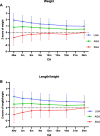Postnatal growth of preterm infants during the first two years of life: catch-up growth accompanied by risk of overweight
- PMID: 33726805
- PMCID: PMC7968173
- DOI: 10.1186/s13052-021-01019-2
Postnatal growth of preterm infants during the first two years of life: catch-up growth accompanied by risk of overweight
Abstract
Background: Early postanal growth of preterm infants has many effects on early and late health. However, evidence on growth pattern in Chinese preterm infant population during early life is insufficient. This study aims to describe the growth trajectory, catch-up growth, and risk of overweight of preterm infants during the first 2 years of life in a Chinese community population.
Methods: All preterm infants (n = 10,624) received routine childcare in one primary maternal and child healthcare network in 8 years were included. Body weight and length/height at corrected age (CA) 40 weeks, CA 3 months, 6 months, 9 months, 12 months, 18 months, and 24 months were extracted and converted to z-scores based on the World Health Organization (WHO) standards. According to the intrauterine growth status, infants were divided into small for gestational age (SGA), appropriate for gestational age (AGA), and large for gestational age (LGA) infants. Changes of z-score were used to describe the growth velocity. Generalized estimating equation (GEE) model was used to analyze growth trajectory trends over time.
Results: Body weight and length/height were overall above the WHO standards during the first 2 years of life. Z-score increased significantly by 0.08 (95% CI: 0.06-0.10) in weight and 0.07 (95% CI: 0.04-0.09) in length/height from CA 40 weeks to 3 months and then levelled off until CA 24 months after adjustment. Almost 90% of AGA and LGA infants achieved growth targets (≥25th percentile of WHO standards), and over 85% of SGA infants achieved catch-up growth (≥10th percentile of WHO standards) before CA 24 months. However, the risk of overweight appeared during this period, with the proportion of infants with the risk of overweight being at the peak at CA 3 months (25.6% of all preterm infants and 39.4% of LGA infants). Growth trajectories of SGA showed increasing trends, but those of LGA showed decreasing trends during the first 2 years.
Conclusions: Body weight and length/height of preterm infants are above the WHO standards in the Chinese community population during the first 2 years of life. Catch-up growth is accompanied by risk of overweight as early as CA 3 months. (349 words).
Keywords: Catch-up growth; Growth; Overweight; Preterm.
Conflict of interest statement
The authors declare that they have no competing interests.
Figures



Similar articles
-
First-year growth of 834 preterm infants in a Chinese population: a single-center study.BMC Pediatr. 2019 Nov 4;19(1):403. doi: 10.1186/s12887-019-1752-8. BMC Pediatr. 2019. PMID: 31684894 Free PMC article.
-
[Analysis of physical growth of preterm infants with different intrauterine growth patterns in Haikou].Zhonghua Er Ke Za Zhi. 2022 Oct 2;60(10):1031-1037. doi: 10.3760/cma.j.cn112140-20220426-00378. Zhonghua Er Ke Za Zhi. 2022. PMID: 36207850 Chinese.
-
Postnatal length and weight growth velocities according to Fenton reference and their associated perinatal factors in healthy late preterm infants during birth to term-corrected age: an observational study.Ital J Pediatr. 2019 Jan 3;45(1):1. doi: 10.1186/s13052-018-0596-4. Ital J Pediatr. 2019. PMID: 30606228 Free PMC article.
-
Nutrition, growth, and allergic diseases among very preterm infants after hospital discharge.Dan Med J. 2013 Feb;60(2):B4588. Dan Med J. 2013. PMID: 23461996 Review.
-
Catch-up growth in small for gestational age babies: good or bad?Curr Opin Endocrinol Diabetes Obes. 2007 Feb;14(1):30-4. doi: 10.1097/MED.0b013e328013da6c. Curr Opin Endocrinol Diabetes Obes. 2007. PMID: 17940416 Review.
Cited by
-
[Longitudinal study on catch-up growth in preterm infants with small for gestational age at corrected ages 0-24 months].Zhongguo Dang Dai Er Ke Za Zhi. 2024 Jan 15;26(1):72-80. doi: 10.7499/j.issn.1008-8830.2307059. Zhongguo Dang Dai Er Ke Za Zhi. 2024. PMID: 38269463 Free PMC article. Chinese.
-
The trajectories of physical growth in 4 months postnatal corrected age among preterm infants discharged from neonatal intensive care units and associated factors: A prospective study.Int J Nurs Sci. 2023 Mar 25;10(2):206-214. doi: 10.1016/j.ijnss.2023.03.016. eCollection 2023 Apr. Int J Nurs Sci. 2023. PMID: 37128488 Free PMC article.
-
Biopsychosocial predictors of rapid weight gain from birth to 6 months.Pediatr Obes. 2024 Dec;19(12):e13170. doi: 10.1111/ijpo.13170. Epub 2024 Aug 29. Pediatr Obes. 2024. PMID: 39209424
-
Growth patterns of preterm and small for gestational age children during the first 10 years of life.Front Nutr. 2024 Feb 26;11:1348225. doi: 10.3389/fnut.2024.1348225. eCollection 2024. Front Nutr. 2024. PMID: 38468696 Free PMC article.
-
Long-term health outcomes of preterm birth: a narrative review.Front Pediatr. 2025 Apr 23;13:1565897. doi: 10.3389/fped.2025.1565897. eCollection 2025. Front Pediatr. 2025. PMID: 40336800 Free PMC article. Review.
References
MeSH terms
Grants and funding
LinkOut - more resources
Full Text Sources
Other Literature Sources
Medical
Miscellaneous

